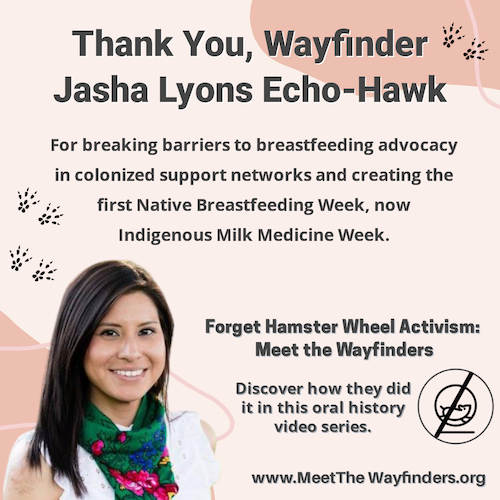Breastfeeding as Companionship: An Ancient Tradition
Restoring the native tradition of breastfeeding
The inaugural Native Breastfeeding Week – now Indigenous Milk Medicine Week – was held August 11-17, 2019. Native Breastfeeding Week will continue to be recognized each year during the week beginning on the second Sunday in August, a month that is recognized as National Breastfeeding Month in the United States. Keep up to date with Native Breastfeeding topics at www.facebook.com/NativeBreastfeedingWeek/. Read more about Native Breastfeeding Week on Kindred.
Breastfeeding as Companionship: An Ancient Tradition
Humans are deeply social beings who expect social embeddedness during development in order to optimize socioemotional intelligence. Our ancestral environment of nomadic foragers, in which the human genus spent 99% of its existence, provided what my lab calls the “evolved nest.”
Recall that human newborns, at full term, are so immature they take 18 months of post-natal growth to look like fetuses of other animals. Their brains are scheduled to more than double in that year and a half (neglected children’s brains do not grow as large). As a result, babies expect an “external womb” experience of needs met quickly. The womb provided nutrients that go far beyond what foods supply, similar to breast milk. We evolved to desire and need breast milk, a mammalian characteristic. Breast milk has all the building blocks for the immune system (food does not). Much like what happens during fetal life in the womb, breast milk provides a tailored cocktail of what that baby needs that day and at that time of day, and by gender! (Clancy, Hinde & Rutherford, 2013)

But breastfeeding is not only about what the baby ingests, it is also about the skin-to-skin experience of being on the body of the caregiver. Those who are unable to provide breastfeeding and must bottle feed can provide this skin-to-skin experience. All feeding can demonstrate how the caregiver holds the baby in mind, teaching the baby the mutual resonance of gaze and touch—looking into baby’s eyes with affection, holding baby close with sensitivity.
The evolved nest respects the basic needs of babies to be “in arms” and in the midst of ongoing community life, as well described by Jean Liedloff (1985) and in anthropological studies (Hewlett & Lamb, 2005; Hrdy, 2009; Sorenson, 1998). Positive touch, nearly constant in babyhood, is vital for the healthy development of biopsychosocial systems (Montagu, 1971). Lack of touch delays development (Ardiel & Rankin, 2010). Breast milk provides key ingredients for a well-functioning brain (Ottolini et al., 2020).
First Nation peoples around the world traditionally offered nested, companionship care, especially in early childhood but also throughout life (including vast support of mothers and nurturing the young). Those opportunities were taken away with various forms of genocidal tactics governments used (and still use) against native peoples (e.g., forced migration off their lands, child removal for boarding school or adoption, laws against traditional practices) (Dunbar-Ortiz, 2014).
Based on the limited data, native mothers have lower rates of breastfeeding initiation (within one hour of birth), shorter duration, and shorter length of exclusivity (no other foods given) relative to other racial/ethnic groups, apart from African Americans.
According to La Leche League (LLL), the foremost organization supporting breastfeeding for almost three-quarters of a century, breastfeeding refers to “the natural feeding of babies and young children with milk from a woman’s breast” with the understanding that this includes chestfeeding for non-binary parents.
LLL has a website for Native Breastfeeding Week, where its rationale and origins are explained:
“Native Breastfeeding Week is a collaborative effort of Indigenous breastfeeding counselors, breast/chestfeeding advocates, community health nurses, lactation consultants, and birth workers as well as breastfeeding mothers/folx. The initial idea originated from our Oklahoma collaborator, Jasha Lyons Echo-Hawk (Seminole/Pawnee/Creek/Omaha/Iowa), a community advocate, public speaker, Birth Doula, local lactivist, and unapologetic brelfie-taker. The intention was to create a space for visibility of all Native Breast/chestfeeding experiences, to learn from each other, celebrate each other, and to call attention to the context of injustice of Native parenting.
Jasha says, “Lactation is my superpower, but it also seems to be treated like a privilege and not a sovereign right regardless of whether you’re Indigenous or not.
More information on Native Breastfeeding Week is available here. Restoring ancestral traditions of breastfeeding will take some effort, including supporting parents so they can carry it out.
Related Posts
Breastfeeding’s Importance—What Science Tells Us
Breastfeeding in the USA—A Little History
Breast Milk Keeps Time and May Set Baby’s Clock
5 Things You Thought You Knew About Breastfeeding
The TREMENDOUS Benefits of Doing What is Normal: Breastfeeding
References
Ardiel, E. L., & Rankin, C. H. (2010). The importance of touch in development. Paediatrics & Child Health, 15(3), 153–156.
Clancy, K.B.H., Hinde, K., & Rutherford, J.N. (2013). Building babies: Primate development in proximate and ultimate perspective. New York: Springer.
Dunbar-Ortiz, R. (2014). An indigenous people’s history of the United States. Boston, MA: Beacon Press.
Hewlett, B.S., & Lamb, M.E. (2005). Hunter-gatherer childhoods: evolutionary, developmental and cultural perspectives. New Brunswick, NJ: Aldine.
Hrdy, S. (2009). Mothers and others: The evolutionary origins of mutual understanding. Cambridge, MA: Belknap Press.
Liedloff, J. (1977). The continuum concept. Cambridge, MA: Perseus Books.
Montagu, A. (1986). Touching: The human significance of the skin. New York: Harper & Row.
Ottolini, KM, Andescavage, N, Kapse, K, Jacobs, M, Limperopoulos, C. Improved brain growth and microstructural development in breast milk–fed very low birth weight premature infants. Acta Paediatr. 2020; 109: 1580– 1587. https://doi.org/10.1111/apa.15168
Sorenson, E.R. (1998). Preconquest consciousness. In H. Wautischer (Ed.), Tribal epistemologies (pp. 79-115). Aldershot, UK: Ashgate.

